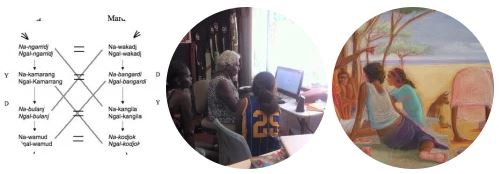“More than one, less than many”: Making and doing conceptual multiplicity as STS work
Our group has found that so often in the finishing of reports, in the tidying up of papers, in the delivering of presentations, the collaborative and complex epistemic, social and material work of arriving at ‘working concepts’ gets left out.
Reflecting on this often invisible labour, here we’ve looked for ways to bring some of these stories to the fore. Messy and complicated stories of the crumbling and dissembling of received concepts assumed by funders and universities, and the mundane and highly analytic work of connecting and separating divergent means for enacting people, places and knowledge practices in just good enough ways.
It’s in displaying and looking back over these often-hidden stories, that we’ve found ourselves now beginning to open up accounts of arriving at concepts which embed working multiplicities.
- As Leonie talked about making and doing re-presentation with Aboriginal people living ‘homeless’ on the beach in Darwin, she also showed the work of writing a book as re-presentation, as activating the hyphen so that the ‘us’ within the book had space to participate in their own representation.
- As Cathy talked about Bininj language work, she also showed ways in which the learning to produce words and sentences involved a slipping and sliding of identity for both language teachers and students as identity became a way both to separate from others and become related into new networks of kinship
- As Simon talked about doing evaluation at the Arafura swamp, he also displayed accounts from collaborators and co-workers showing this evaluation work as at once an active process of renewal and creation of video objects that non-Indigenous collaborators could understand and that would support more renewal work by children and grandchildren
- As Michaela talked about doing credentialing as both connecting the modern academy and djalkari (Yolŋu foundations), she also displayed accounts from collaborators which revealed this work as also connecting ways of qualifying as both something bestowed or placed upon a person, and as a practice of finding or revealing what this person always was already.
- As Jennifer talked about generating evidence of government engagement practices, she also showed the gradual process of generating different kinds of objects which iteratively built multiplicity into evidencing practices
- And as Yasunori talked about working with Dr Waymamba Gaykamaŋu doing teaching and language work, he also showed means by which the ‘languageness’ with which they were both engaged could be legitimately maintained as both co-constitutive of place and something able to be shown in black and white ink in dictionaries and books.
In telling stories of Making and Doing STS work, we’ve invited you into these interstitial spaces. We’ve also invited you to travel through processes of – somehow or other – arriving at at working concepts which allow divergence amidst the work of also making partial connections.
This analysis page here has seen us offering one more commentary. One further iteration of looking back over the collection of concepts which have emerged in telling our stories. Involving you in the relations of working in our particular places and projects, while also reaching towards a way of collectively expressing a form of STS Making and Doing practice. A final account of work that makes sense amidst the groups we work with and for, and which allows this collaborative work to travel, to make a difference, to intervene. Work that is differentiated but not disaggregated, that is both partial and agential, that is always at once “more than one, less than many” (Strathern, 2005).
References:
Strathern, M. (2005). Partial Connections. Lanham: AltaMira Press.
| Song: The Bridge by Yirrmal Marika, North-East Arnhem Land
We are standing on a bridge It don’t matter to that river So much wreckage lying under
|
It don’t matter to that river The spirit sings with one voice, It don’t matter to that river |
It don’t matter to that river The spirit sings, the spirit sings Are we walking? |
Fatal error: Allowed memory size of 268435456 bytes exhausted (tried to allocate 23070008 bytes) in /var/www/lod.cdu.edu.au/wp-includes/class-walker-comment.php on line 203

